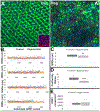Evidence of regional specializations in regenerated zebrafish retina
- PMID: 34653519
- PMCID: PMC8608723
- DOI: 10.1016/j.exer.2021.108789
Evidence of regional specializations in regenerated zebrafish retina
Abstract
Adult zebrafish are capable of functional retinal regeneration following damage. A goal of vision science is to stimulate or permit a similar process in mammals to treat human retinal disease and trauma. Ideally such a process would reconstitute the stereotyped, two-dimensional topographic patterns and regional specializations of specific cell types, functionally important for representation of the visual field. An example in humans is the cone-rich fovea, essential for high-acuity color vision. Stereotyped, global topographic patterns of specific retinal cell types are also found in zebrafish, particularly for cone types expressing the tandemly-replicated lws (long wavelength-sensitive) and rh2 (middle wavelength-sensitive) opsins. Here we examine whether regionally specialized patterns of LWS1 and LWS2 cones are restored in regenerated retinas in zebrafish. Adult transgenic zebrafish carrying fluorescent reporters for lws1 and lws2 were subjected to retinal lesions that destroy all neurons but spare glia, via intraocular injection of the neurotoxin ouabain. Regenerated and contralateral control retinas were mounted whole or sectioned, and imaged. Overall spatial patterns of lws1 vs. lws2 opsin-expressing cones in regenerated retinas were remarkably similar to those of control retinas, with LWS1 cones in ventral/peripheral regions, and LWS2 cones in dorsal/central regions. However, LWS2 cones occupied a smaller fraction of regenerated retina, and several cones co-expressed the lws1 and lws2 reporters in regenerated retinas. Local patterns of regenerated LWS1 cones showed modest reductions in regularity. These results suggest that some of the regional patterning information, or the source of such signals, for LWS cone subtypes may be retained by undamaged cell types (Müller glia or RPE) and re-deployed during regeneration.
Keywords: Cone; Development; Pattern; Regeneration; Regional specialization; Retina; Zebrafish.
Copyright © 2021 The Authors. Published by Elsevier Ltd.. All rights reserved.
Figures


References
-
- Cameron DA, Carney LH, 2000. Cell mosaic patterns in the native and regenerated inner retina of zebrafish: implications for retinal assembly. The Journal of comparative neurology 416, 356–367. - PubMed
-
- Cameron DA, Vafai H, White JA, 1999. Analysis of dendritic arbors of native and regenerated ganglion cells in the goldfish retina. Visual Neuroscience 16, 253–261. - PubMed
Publication types
MeSH terms
Grants and funding
LinkOut - more resources
Full Text Sources
Molecular Biology Databases
Research Materials

